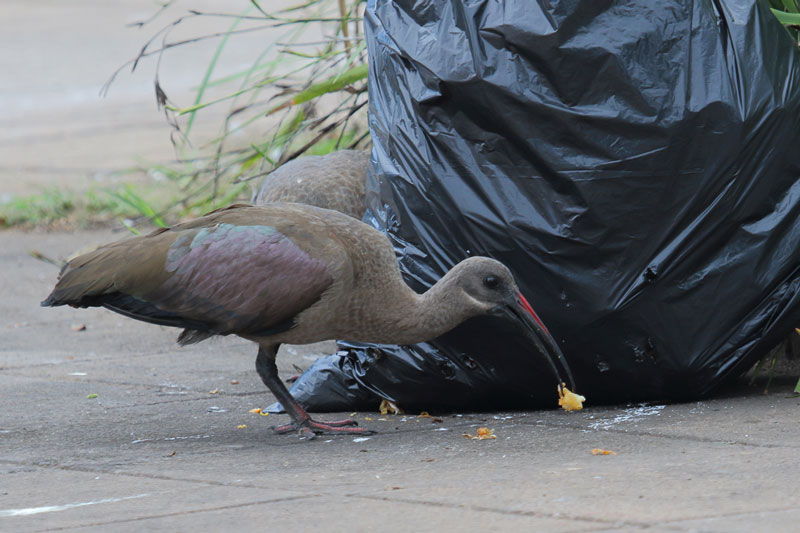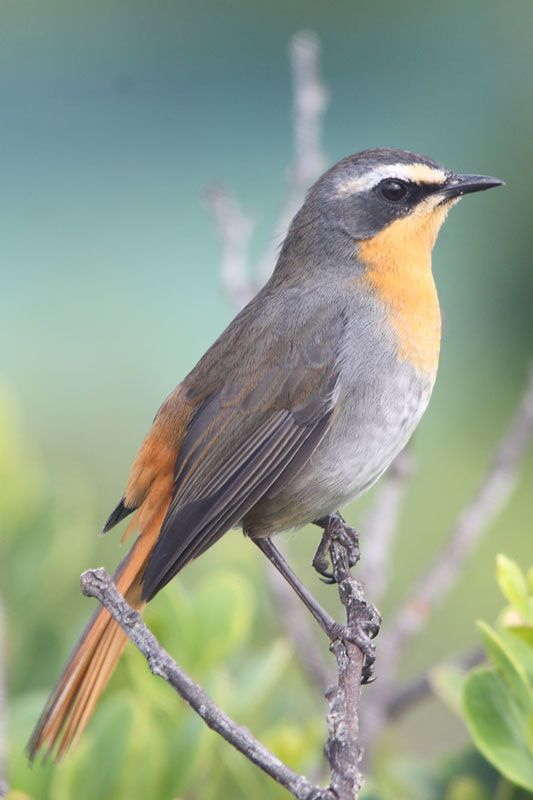Home-fed in Kloof
Birds that permanently live and feed in the Kloof area
Text Peter Spence Photographs David Allan, Shane McPherson, Johann Knobel
Following on from our article in the January edition of Leopard’s Echo, when the focus was on nesting habits of the Kloof’s top ten residents, we now want to look at what they eat. To restrict the list we have selected the top ten carnivores and insectivores. To put it another way, we have left out the vegetarians. These birds are still part of the 6% who occur in 90% of all lists.
1. Hadeda

We have already referred to that great lawn-keeper, the Hadeda Ibis. They forage mostly on moist ground, probing for prey with their long bills. Nevertheless, over 60% of their food is found at the soil surface. They also do a good clean-up job of fallen scraps of food, though there might be a little misunderstanding since they are reported to be partial to supplementing their diets from bowls of dog food.
2. Cape Robin-chat

This questionable habit is shared by South Africa’s favourite bird the Cape Robin-chat. We have seen photos of this pretty little bird looking very innocent, standing on the edge of dog food bowls. They usually forage singly or with their mate, spending most of the time on the ground, whisking leaves and litter. In fact they forage in all strata, capturing prey on foliage, tree trunks and rocks, and hawk flying insects, including termite alates and fruit flies. Their most common prey are ants, present in 87% of stomach and faecal samples. No wonder they are South Africa’s favourite bird! This is followed by beetles (68%), moths and caterpillars (46%), termites (35%), wasps and bees (16%), plant and assassin bugs (15%), spiders (11%), crickets and mantids (9%), and flies (9%).
3. Brown-hooded Kingfisher

The Brown-hooded Kingfisher hardly lives up to its name, inhabiting mostly woodland and bush where there aren’t many fish, and feeding on a wide range of small fry, including locusts, grasshoppers, crickets, mantids, cockroaches, beetles, caterpillars, scorpions, etc. They operate solitarily or in pairs, perching quietly for long periods on branch or wire, exposed or in shade, always alert for prey. They fly down fast to seize prey from the ground, briefly alighting or, more commonly, seizing it without alighting and returning to perch. Large items are battered against the branch and swallowed head first. They are rarely observed actually fishing, but they do like to bathe by making numerous dives into water from a low perch.
4. Olive Thrush

Shy in natural habitats, the Olive Thrush is bolder and more friendly in gardens. It forages mostly on the ground, favouring leaf litter, which it flicks aside with its bill, or scratches backwards with one foot. You may notice how it runs to a new spot, stops and listens for prey movements. Earthworms are pulled out of the ground following this behaviour. In addition to a wide range of invertebrates they may seasonally indulge in wild fruits, very often of alien species.
5. Common Fiscal

Previously known as the Jackie Hangman or Butcher Bird due to its habit of impaling its prey on acacia thorns (or barbed wire) for later consumption, the Common Fiscal has never been a popular bird. It hunts from exposed perches, such as telephone lines, using a sit-and-wait technique. Prey is usually caught following a shallow glide. Small prey is usually eaten on the ground while larger victims are carried back in its bill to the same or another perch. Vertebrates and large insects are sometimes taken back to the perch in its feet, holding the body with one foot and tearing at it with its hooked bill. One ‘larder’ spread over 150m barbed wire fence had 3 young rats, 14 grasshoppers, 4 beetles, 1 cricket and 1 caterpillar ready to eat. Sometimes included in its menu are chicks and small birds, which does nothing for its popularity.
6. Golden-tailed Woodpecker

Its presence given away by its shrill scream, the Golden-tailed Woodpecker often joins in with ‘bird parties’ in the woodlands and forests where it is common. ‘Bird parties’ are mixed species foraging flocks in which different species work together as they feed. The Woodpecker works along mostly dead branches, tapping and probing with its bill, sometimes working at one spot for a protracted period. They glean ants from tree surfaces, and excavate subsurface nests, probing with its sticky tongue.
7. Southern Black Tit

The Southern Black Tit also forages along branches, in crevices on bark and among leaves of the mid and upper canopy. You can see the attentive posture of the bird in the photo as it looks around for prey. Extracts chalcid wasp larvae from pods of bushwillow and acacia trees by picking a pod, holding it down with its foot and pecking a hole to extract the larva.
8. African Pipit

The species on our list with the widest distribution in Africa is the African Pipit. A somewhat drab brown bird, it is found from the Cape to Ethiopia, the Sudan and Somalia – anywhere where the vegetation is short. It forages on the ground or from low perches, readily using agricultural land, especially fallow fields. It mainly locates its prey visually by walking – it sometimes has a very strutting gait. It breaks up dung in search of larvae or digs at roots of grass clumps in search of insects. It eats mostly insects including centipedes, grasshoppers and beetles.
9. Neddicky

One group of birds we have not touched on are the Cisticolas. LBJs to most people. One species makes it into our list of top 10 Kloof birds – the cute little Neddicky. Found in a wide range of habitats it tends to forage low down in the undergrowth, mostly on the ground, especially in open spaces between bushes. It forages with rapid, darting, mouse-like movements in pursuit of flying or jumping insects. It searches flowers and leaves for its meal, occasionally hawking prey aerially. Eats mostly insects, including termites, grasshoppers, mantids, moths and caterpillars.
10. African Crowned Eagle




Finally, for our 10th bird, we move on from the smallest to the largest and most majestic – the African Crowned Eagle. We are privileged to live in a part of the world with a high concentration of this magnificent species, and many of you might have met Shane McPherson who has been doing a study of this bird in our suburban surroundings. This eagle is a forest species, resting for long periods just inside the canopy. They can often be heard calling as they soar high over their territory in a splendid display of aerobatics. They take most of their prey on the ground, but will crash into dense foliage in pursuit of a meal. A pair sometimes hunt monkeys co-operatively – one bird soars over the canopy, eliciting alarm calls from monkeys, revealing their location for the mate following behind. Their prey is struck with a downward blow of an open foot – the massive hind claw penetrates the skull, killing the animal instantly. Large prey items that cannot be lifted are partly eaten and dismembered on the ground, then cached in trees. 96% of prey are mammals, the rest being birds and some reptiles. Of the mammalian prey, 42% are hyraxes (dassies), 23% antelope and 7% primates. Most of the avian prey are game birds and Hadedas, taking us neatly back to the beginning of this article.
We have included quite a lot of detail on food sources for a variety of birds in this article, which demonstrates how each species has its own role to play in the balance of nature. Most of the species described here are looking for food almost continuously all day – in order to have enough energy to survive. But what is also demonstrated is how different species draw from and contribute to different aspects of an ecosystem, and the whole thing works.
We hope your curiosity will lead to a little more time studying the behaviour of our friends, the birds.
Sources
Source:
Roberts Birds of Southern Africa – VIIth Edition
Photographs:
Photographs courtesy of David Allan, Shane McPherson and Johann Knobel.

About the author
Peter was born and raised in the sub-tropical haven of the then Lourenço Marques, now Maputo but was schooled in KZN. With a Mechanical Engineering degree from Cambridge he focused on his engineering career until moving to Durban in the mid 70’s and immediately developed an interest in birds. He has travelled extensively throughout southern Africa on birding holidays which helped him reach his target of 700 bird sightings. More recently he has turned his focus to bird atlasing and is a valuable contributor to the Southern African Bird Atlas Project. He is also a one of the organisers of the Krantzkloof Bird Club.